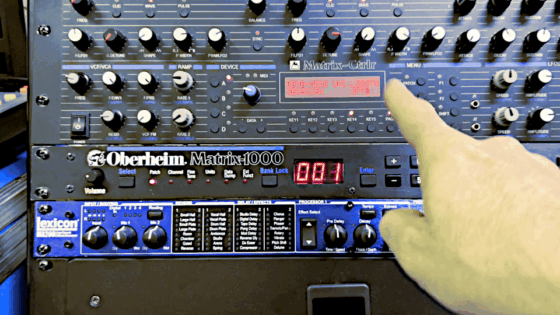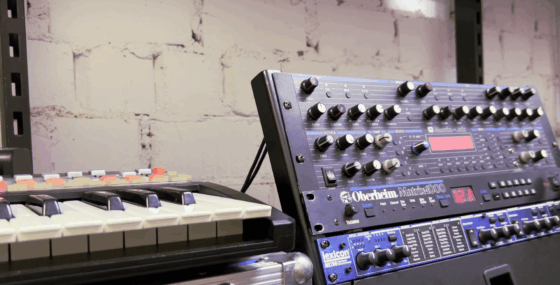Forgive me for inserting a slice of analog synth porn here:
Although the Matrix-1000 is nearing 40, it’s very much alive and kicking. It’s an analog that you can still, kind of, afford – and, more important, that still works. The Matrix-1000 ROM is by far the most popular firmware of all the upgrades Bob Grieb ever designed; they must have sold loads of that synth. And they have survived to this day, the occasional battery failure or dying voice chip nonwithstanding.
The very quality that made it a cheap, second-rate option back then – its lack of immediate controllers – is no longer a problem. When I bought my Matrix around 1990, I was stuck to the presets; these days, MIDI controllers are easy to find.
As a couple of people have asked about recommendations for controllers, you will find a collection of options I came across. It is worth noting that most of them work with the earlier Matrix-6/6R version of the synth as well although it lacks the option to use NPRN as well as dedicated commands to control the modulation matrix.
Some software editor options
If you are going for software, Edisyn (🌐 Github) seems to be a good option: a Java-based, cross-platform editor-librarian that is still being maintained and developed, other that its ancestor JSynthLib. There is 🌐 Possemo’s panel for open-source editor Ctrlr, for Mac and Windows. 🌐 Coffeeshopped’s Patch Base editor/librarian has a good Matrix-1000 module and runs on Macs as well as iPads, making an old iPad with a Camera Connection Kit and a MIDI cable a good stand-alone controller option. (And I’m really sorry that the controller panel I designed in 2014 no longer works, as the TB MIDI Stuff app it relies on is no longer supported by developer and modern IOS).
But if you are going for external hardware, why stop at virtual controls? There are dedicated controllers to feed your GAS, and I can testify that they are really SO MUCH MORE fun, as I own two of them: the Alpes Machines controller, and a Novation SL MK II controller keyboard programmed as a very capable one-knob-per-function controller with display.
It makes sense to distinguish between more modern and older hardware options; controllers like the SL Mk II controller are out of production for some time now.
Modern hardware
Alpes Machines MATRIX CTRL
- Have I tried it? Absolutely.
- Pros: One knob per function, sequencer/arpeggiator, up to 4 Matrixes,
- Cons: Tedious updating process, not quite as intuitive as the Stereoping, building it yourself is quite some work
Arduino-based homebrew project, started by Julien in France quite some time ago. Available as a DIY kit, or pre-built. Oh, and you can get Bob’s firmware from him as well. Features 32 knobs, so a bit of menu-diving is necessary to reach the more esoteric parameters like Reassign/Rob, but it has a patch manager and a beautiful arpeggiator to make up for that, and you can chain up to 4 Matrixes to build a 48-oscillator analog monster around it.
Stereoping Programmer
- Have I tried it? Not yet
- Pros: One knob for everything
- Cons: Expensive, no chaining/master option
A huge rack controller in the same range as the Alpes Machines controller, with even more hands-on controls: 49 knobs, and a more intuitive layout, at least in my opinion. An absolute beauty that one, and you can also save €120 if you DIY (although I think that you may be well-advised to spend that money).
Stereoping Controller
- Have I tried it? No
- Pros: Compact and cheap
- Cons: Shift function: not every parameter gets a knob; no display
Stereoping’s more compact and cheaper controller, featuring 16 knobs in three switchable layers. At under 200 Euros for the DIY version, it is an affordable alternative to the Access controller hardware from back then. With 48 parameters, you won’t be able to control everything – the mod matrix cannot be modified – but does it matter? Most of the time, you’ll just be turning filter and envelope controls anyway.
Electra One (Hardware controller with user-created patch)
- Have I tried it? Not yet.
- Pros: Dedicated hardware with a nice form factor; you might use it for more hardware than just the Matrix
- Cons: At €500, it’s expensive.
An interesting design by a Czech company: Combining 12 rotary knobs with a touch display to have an intelligent hardware controller. There’s also a cheaper Mini version. And for the nerds amongst us, it is highly configurable using Lua, a programming language for visual artists and other pretentious bastards.
Old-school hardware
For setting parameters from a hardware controller, you can use anything capable of sending NRPN commands – provided that you have the V1.2x update, as the NRPN routine was disabled by a bug in the factory firmware: Just have a look at the parameter chart (PDF) and send the NRPN value as #6 high-order byte with offset – more on this here.
Some old-school controllers have also a limited capacity of sending SYSEX messages, and this is what the existing templates for these units use for controlling the modulation matrix.
Novation SL Mk II
- Have I tried it? I actually did one of the panels; find it here
- Pros: The keyboard version has a great keybed as well
- Cons: No longer in production, hard to memorize the controls, more than one function per knob, and a need to switch between layers
A curious mixture: 8 touch-sensitive endless encoders, 8 rotary knobs, 8 sliders, and loads of knobs, paired with a display and, in the keyboard version, a great keybed with Aftertouch. Not enough controls to reach every parameter though.
Behringer BCR2000 (Hardware controller with user-created patch)
- Have I tried it? Not yet.
- Pros: LED display of
- Cons: Need to switch between layers, no longer in production
The BCR2000 has lots of fans in the Matrix-1000 ownership, and once again, it might come handy to control more than just the Matrix: 32 endless encoders, each with an LED ring for showing the actual value of the control (which is a quite ingenious way to control a synth, as I know from my Korg R3.) The template for the Matrix-1000 can be found on 🌐 Github. Behringer also built a version with 16 controls, 8 of which were motor faders(!), called BCF2000; that might be harder to use.
Access Matrix Programmer
- Have I tried it? I wish.
- Pros: Vintage hardware itself
- Cons: A bit dated; unobtainium
Before Access built their Virus synth, and later on, the Kemper modeling amps, they made this – the first hardware controller for the Matrix. It looks great, and it is a piece of synth history, but it is still more limited than, say, the Stereoping Controller with about the same amount of controls – it does not offer you control of the modulation matrix, for one. But does it matter? Definitely not. The Access controller has become quite the collector’s item itself, which means that if you manage to find one, it will cost you.
Also running…
I guess there are more. Many more. So if you think there are other controllers that deserve a mention, and know where to find the template to use them with the Matrix, drop me a line.
Verwandte Artikel:
- Matrix-1000-Sensation: Seltener Bug nach über 30 Jahren endlich entdeckt! (Dienstag, 24. Dezember 2024; Schlagworte: analog, analog synthesizer, Firmware, Matrix-1000, Oberheim Matrix-1000)
- The Humble Art of iPad Music: A Rant (Mittwoch, 21. März 2012; Schlagworte: Animoog, App, iPad, Korg iMS-20, music, Musik, Softsynth, Sunrizer, Synthesizer, SynthX)
- Midifying Jenny, Step 1: Replacing the old keyboard chip with a Teensy (Sonntag, 6. Januar 2019; Schlagworte: Arduino, Jen SX-1000, Löten, Midi, Modding, Retro, Synthesizer, Teensy)

